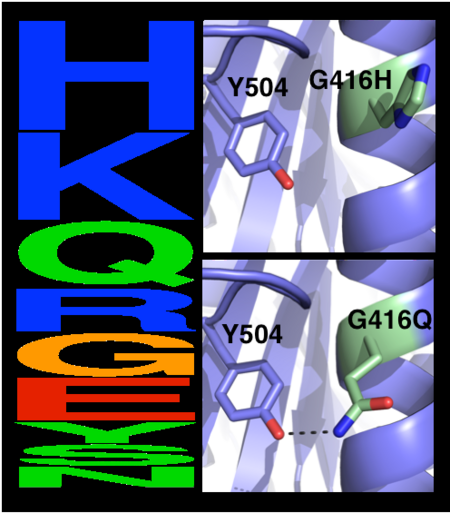Journal:Molecular Cell:1
From Proteopedia

Automated computational design of human enzymes for high bacterial expression and stabilityAdi Goldenzweig, Moshe Goldsmith, Shannon E Hill, Or Gertman, Paola Laurino, Yacov Ashani, Orly Dym, Tamar Unger, Shira Albeck, Jaime Prilusky, Raquel L Lieberman, Amir Aharoni, Israel Silman, Joel L Sussman, Dan S Tawfik and Sarel J Fleishman [1] Molecular Tour
The algorithm, PROSS (Protein Repair One-Stop Shop), is available at http://pross.weizmann.ac.il . The structural basis underpinnings the stabilization in the designed variant dAChE4. Wild type hAChE (PDB entry: 4ey4) is shown in blue and 51 mutated positions, which are distributed throughout dAChE4, are indicated by orange spheres. The choice of mutations at Gly416 in hAChE illustrates the role of the two filters,
that are used in pruning false positives (see the static image below). Position 416 is located on a partially exposed helical surface, where the small and flexible amino acid Gly is likely to destabilize hAChE. Indeed, in the alignment of AChE homologs, Gly appears infrequently and His is the most prevalent amino acid. Modeling shows, however, that in this specific context of hAChE, His adopts a strained side-chain conformation; in contrast, Gln, the third most prevalent amino acid, is predicted to be most stabilizing owing to its high helical propensity and favorable hydrogen-bonding with Tyr504. The combined filter, therefore, favors Gln over His for downstream design calculations.  Eliminating potentially destabilizing mutations through homologous-sequence analysis and computational mutation scanning. Left: Sequence logo for hAChE position Gly416. The height of letters represents the respective amino acid’s frequency in an alignment of homologous AChE sequences. The evolutionarily ‘allowed’ sequence space (PSSM scores ≥0) at position 416 includes the 9 amino acids shown. Right: Structural models of mutations to the evolutionarily favored amino acid His, and to Gln, which is favored by Rosetta energy calculations. The His side chain is strained due to its proximity to the bulky Tyr504 aromatic ring, whereas the Gln side chain is relaxed and forms a favorable hydrogen bond with Tyr504 (dashed line) Scenes highlight stabilizing effects of selected mutations (in red), dAChE4 (PDB entry: 5hq3, green) compared to hAChE (PDB entry: 4ey4, cyan): Sub-Ångstrom accuracy in alignment of the catalytic triad Ser203, Glu334, and His447 in the crystallographic structure of dAChE4 (PDB entry: 5hq3, green) compared to hAChE (PDB entry: 4ey4, cyan). Sub-Ångstrom accuracy in alignment of key residues in the vicinity of the catalytic triad.
Comparison of the dAChE4 design model (yellow) with the solved crystal structure (PDB entry: 5hq3, green) and (wild-type hAChE (PDB entry: 4ey4, cyan):
PDB reference: Stable, high-expression variant of human acetylcholinesterase, 5hq3. |
| ||||||||||
- ↑ Goldenzweig A, Goldsmith M, Hill SE, Gertman O, Laurino P, Ashani Y, Dym O, Unger T, Albeck S, Prilusky J, Lieberman RL, Aharoni A, Silman I, Sussman JL, Tawfik DS, Fleishman SJ. Automated Structure- and Sequence-Based Design of Proteins for High Bacterial Expression and Stability. Mol Cell. 2016 Jul 21;63(2):337-346. doi: 10.1016/j.molcel.2016.06.012. Epub 2016, Jul 14. PMID:27425410 doi:http://dx.doi.org/10.1016/j.molcel.2016.06.012

